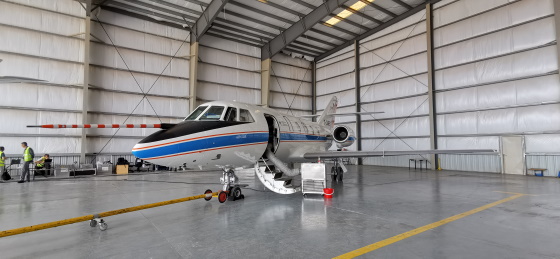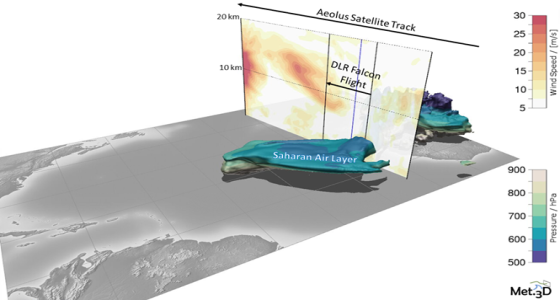- News
- Wind measurement campaign vali...
Wind measurement campaign validates Aeolus data
27 Oct 2021
Aeolus VAlidation Through Airborne LidaRs in the Tropics (AVATART) was one of the two scientific campaigns carried out on Sal Island, Cape Verde during the month of September 2021. Prepared, implemented and executed by the German Aerospace Center (DLR) with support from ESA, AVATART was part of the international framework of the Joint Aeolus Tropical Atlantic Campaign (JATAC).

Numerical Weather Prediction (NWP) impact studies conducted by the European Centre for Medium-Range Weather (ECMWF) and Germany's National Meteorological Service, the Deutscher Wetterdienst (DWD) as part of the Aeolus Data Innovation and Science Cluster (DISC) as well as the German Experimental Validation and Assimilation of Aeolus observations (EVAA) Initiative, confirmed that Aeolus wind data are very important in the tropical region, not only for improving wind field models, but also for secondary model background information such as humidity fields.
As Aeolus Rayleigh and Mie wind products are affected by the presence of aerosol in the atmosphere, AVATART aimed to further explore its potential as a wind error source for the satellite's measurements and validate wind measurement errors in the tropical region around Cape Verde. The archipelago was chosen as a base as it allows for observations of the tropical dynamics of the Saharan dust layer, the African Easterly Jet, the Subtropical Jet and the Intertropical Convergence Zone.
Adapted to science
The AVATART campaign operated from Amílcar Cabral International Airport on Sal Island, Cape Verde. It used a DLR Falcon 20 aircraft, heavily modified for scientific purposes, to perform Aeolus under flights from 6 to 28 September 2021. A shutter door was installed under the fuselage, which opens during flights so that the instruments aboard the Falcon can see into the atmosphere below with their laser systems.
DLR Flights Experiments Pilot Thomas van Marwick gives a tour of the Falcon 20 and explains the modifications that have transformed it into a flying scientific lab.
A nose boom was also mounted on the Falcon for the campaign, so standard meteorological parameters such as pressure, wind speed, wind direction and turbulence, temperature and humidity, could be collected as in-situ data at flight level. Because of the additional power required by the scientific equipment aboard, the DLR Falcon 20 was also equipped with additional power generators.
Instruments for Aeolus Validation
For the AVATART campaign, the DLR Falcon 20 carried two lidar instruments: the Atmospheric Laser Doppler Instrument (ALADIN) airborne demonstrator A2D and a coherent Doppler wind lidar system (2-µm DWL). DLR used the same aircraft and instruments during the WindVal campaigns for Aeolus pre-launch validation in 2015 and 2016 and during the commissioning phase in late 2018 as well, as for two additional validation campaigns in Europe (AVATARE) and Iceland (AVATARI) in spring and autumn 2019, covering FM-A and FM-B operational periods.
The A2D instrument is a prototype of Aeolus' own ALADIN instrument and was developed by DLR several years before the satellite's launch to verify the ALADIN measurement principle. Since then, A2D has been used to validate Aeolus calibration procedures, retrieval algorithms and wind product quality during several validation/calibration campaigns.
The successful demonstration of the potential of Aeolus and the detailed technical and operational knowledge gained before launch thanks to A2D provided an important support throughout the development phase and paved the way for the quick commissioning of the mission, as well as its continuous performance.
DLR Scientist Benjamin Witschas presents the two instruments aboard the Falcon 20 used during the AVATART campaign.
Like Aeolus's ALADIN instrument, A2D allows for a broad vertical and horizontal coverage across the troposphere thanks to its receiver, which comprises a Rayleigh and a Mie channel for analysing both molecular and particulate backscatter signals.
The 2-µm Doppler wind lidar system meanwhile acts as a reference system for validation of Aeolus measurements. It's equipped with a double-wedge scanner that helps determine the wind vector and wind speed with high accuracy and precision.
A successful campaign
The DLR Falcon 20 performed 11 Aeolus underflights during the AVATART campaign, four of which coincided with underflights of the French CADDIWA campaign's SAFIRE Falcon and the Slovenian CAVA-AW campaign's Advantic WT-10 aircraft. The number of flights executed depended on weather conditions. As lidar instruments cannot see through clouds, the Falcon was grounded when the sky above Cape Verde was overcast.
"We were very happy to find the different targeted tropical weather conditions we hoped for within the Falcon range limits and that we could also keep the good performance of the sensitive A2D lidar throughout the demanding temperature conditions during the campaign," says Christian Lemmerz, who led the DLR Aeolus Airborne Validation activities and prior A2D developments.

"With its 11 underflights, the AVATART campaign was our most successful Aeolus validation campaign to date." Various weather forecast and flight planning tools were used like Met.3D, which allows to fuse and visualise various atmospheric model data in the region and along the predicted Aeolus track.
With the campaign successfully concluded, it is now up to the scientists to analyse the data collected during AVATART and present their findings to the community within the Aeolus 3rd Anniversary Conference.